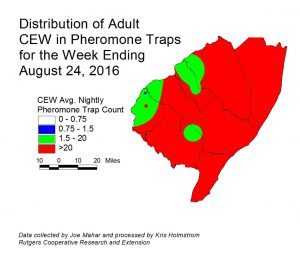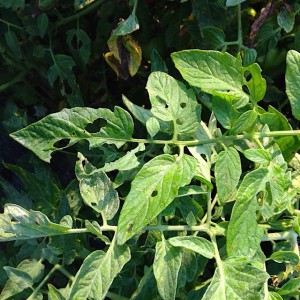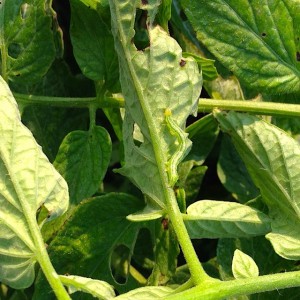Sweet Corn
European corn borer (ECB) adult activity has declined to nearly nothing at this time, and no map image is in this edition. The second flight was extremely low, with fall armyworm injury much more dominant this year. It is possible that we will have a partial third flight, but as the second was so low, it is not likely that it would be of much consequence. As always, consider treating when the number of infested plants in a 50 plant sample exceeds 12%. Any planting remaining at or above threshold as it proceeds to full tassel should be treated, as this is the last stage at which ECB larvae will be exposed and vulnerable to insecticidal sprays.
See the 2016 Commercial Vegetable Recommendations Guide for insecticide choices.
The highest nightly ECB catches for the previous week are as follows:
| Beckett 1 | Lawrencevile 1 |
| Chester 1 | Little York 1 |
| Crosswicks 1 | Matawan 1 |
| Georgetown 1 |
Fall armyworm (FAW) infestations continue throughout NJ, with high infestation rates now appearing in all parts of the state. This pest can be devastating to small corn plants, and in fact the worst infestations are currently in shorter whorl stage plantings. Fields down to seedling stage should be scouted weekly for signs of infestation. Treat when FAW alone or in combination with ECB damage exceeds 12% plants infested. FAW do not respond well to pyrethroid insecticides. The most useful products are those in the IRAC group 28 class (Coragen, Exirel) or the IRAC group 5 class (Radiant, Entrust), or combination products including these classes. See the 2016 Commercial Vegetable Recommendations Guide for insecticides effective against FAW.
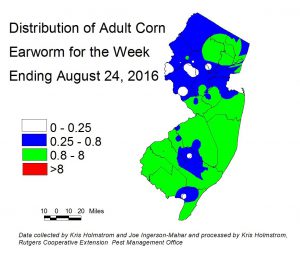 Corn earworm moth (CEW) activity has decreased with the onset of cool evening temperatures and change of wind direction since Sunday. Despite this, weekly averages remain fairly high, and we may expect a further increase in activity as temperatures warm through the weekend. Activity is highest in south and central counties but increases have been detected all over NJ (see CEW map). Some North Carolina traps are again registering increases, although Virginia’s and Delaware’s networks are showing catches similar or lower to ours. It is interesting to note that Va Tech’s assay of CEW moths for pyrethroid resistance (which they do every year) is again showing that a significant percentage of the population (38% this year) is resistant to cypermethrin. You can see this data at: http://blogs.ext.vt.edu/ag-pest-advisory It is advisable to incorporate materials into the spray program that have different modes of action from the pyrethroids. This includes IRAC 28 materials like Coragen, Exirel and Besiege, as well as IRAC 5 (Radiant, Entrust (OMRI approved), and Blackhawk)). This current population is still lower than we traditionally get in mid-August. More CEW may continue to arrive in advance of frontal low pressure systems. Growers should be checking CEW activity frequently, and adjust spray schedules according to local activity.
Corn earworm moth (CEW) activity has decreased with the onset of cool evening temperatures and change of wind direction since Sunday. Despite this, weekly averages remain fairly high, and we may expect a further increase in activity as temperatures warm through the weekend. Activity is highest in south and central counties but increases have been detected all over NJ (see CEW map). Some North Carolina traps are again registering increases, although Virginia’s and Delaware’s networks are showing catches similar or lower to ours. It is interesting to note that Va Tech’s assay of CEW moths for pyrethroid resistance (which they do every year) is again showing that a significant percentage of the population (38% this year) is resistant to cypermethrin. You can see this data at: http://blogs.ext.vt.edu/ag-pest-advisory It is advisable to incorporate materials into the spray program that have different modes of action from the pyrethroids. This includes IRAC 28 materials like Coragen, Exirel and Besiege, as well as IRAC 5 (Radiant, Entrust (OMRI approved), and Blackhawk)). This current population is still lower than we traditionally get in mid-August. More CEW may continue to arrive in advance of frontal low pressure systems. Growers should be checking CEW activity frequently, and adjust spray schedules according to local activity.
The highest nightly CEW catches for the previous week are as follows:
| Georgetown 5 | New Egypt 3 | Woodstown 2 |
| Jones Island 4 | Allentown 2 | Farmingdale 1 |
| Crosswicks 3 | Old Bridge 2 | Milltown 1 |
| Denville 3 | Pedricktown 2 | Sparta 1 |
The limited CEW pheromone trap network in the southern counties also increased over the weekend, and then declined somewhat as nights cooled. Higher overall catches were seen in most parts of southern NJ (see CEW pheromone map). The low number of traps results in broad areas of color within the map. It is critical that growers monitor local CEW moth numbers. At present, this population constitutes a significant threat to silking corn.
The highest nightly CEW pheromone trap catches for the previous week are as follows:
| Green Creek 49 | Jobstown 21 | Beckett 16 |
| Monroeville 46 | East Vineland 18 | Woodstown 16 |
| Elm 28 | Springdale 17 | Berlin 11 |
For silking sweet corn, the following spray schedules are warranted.
Silking Spray Schedules*:
South – 3 days
Central – 3-4 days
North – 4-5 days
*These recommendations are based on regional catches.
Brown Marmorated Stinkbug (BMSB)
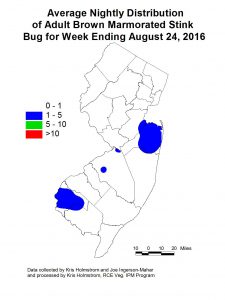 BMSB numbers decreased dramatically in many NJ blacklight traps this past week. Again, this may be a result of cooler evening temperatures. Nymphs and adults are still appearing in low numbers in pepper and corn plantings. It is important that host crops like peppers be scouted regularly for the presence of BMSB and other stinkbugs at this time. It is often most productive to walk slowly down pepper rows, scanning plants ahead. BMSB and other stink bugs tend to bask near the tops of plants, especially in the morning hours.
BMSB numbers decreased dramatically in many NJ blacklight traps this past week. Again, this may be a result of cooler evening temperatures. Nymphs and adults are still appearing in low numbers in pepper and corn plantings. It is important that host crops like peppers be scouted regularly for the presence of BMSB and other stinkbugs at this time. It is often most productive to walk slowly down pepper rows, scanning plants ahead. BMSB and other stink bugs tend to bask near the tops of plants, especially in the morning hours.
The highest nightly BMSB trap catches for the previous week are as follows:
| Jones Island 2 | Centerton 1 | Matawan 1 |
| Medford 2 | Crosswicks 1 | Old Bridge 1 |
| Woodstown 2 | Dayton 1 | Pedricktown 1 |
| Beckett 1 | Farmingdale 1 | South Brangh 1 |
Pumpkins and Winter Squash
Powdery mildew (PM) is active on pumpkin and winter squash fields throughout NJ. The action threshold for commencement of the protectant fungicide program for PM is 2 lesions per 100 older leaves. See the 2016 Commercial Vegetable Recommendations Guide for a list of appropriate protectant fungicide rotations for PM control.
Down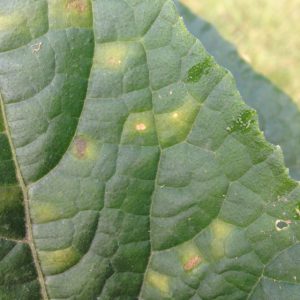 y mildew (DM) is present on cucumbers in all parts of NJ (see photo at left). DM has been reported on the eastern shore of Virginia on butternut squash. While this site may not currently be a direct threat to NJ pumpkin and winter squash acreage, it is an indication that races of the pathogen that are capable of infecting these important crops are getting closer. All growers should be applying appropriate protectant fungicides plus DM specific materials to cucumbers and cantaloupes at this time, and scouting frequently and preparing to make DM applications on pumpkins and winter squash. As yet, RCE personnel have not been able to confirm DM on crops other than cucumber, and the only crop in the DM sentinel plot at Snyder Research Farm in Hunterdon county that is infected is cucumber. DM lesions appear as yellow areas on the upper leaf surface with leaf veins making distinct borders to the lesions. On the lower leaf surface, beneath the lesions, dark spores may be seen if conditions are moist. For more information on the regional presence of DM as well as comprehensive, weekly forecasts, see the following website: http://cdm.ipmpipe.org. At this time, with the recent change in weather, NJ is at low risk of new infections according to the Cucurbit Downy Mildew Forecast.
y mildew (DM) is present on cucumbers in all parts of NJ (see photo at left). DM has been reported on the eastern shore of Virginia on butternut squash. While this site may not currently be a direct threat to NJ pumpkin and winter squash acreage, it is an indication that races of the pathogen that are capable of infecting these important crops are getting closer. All growers should be applying appropriate protectant fungicides plus DM specific materials to cucumbers and cantaloupes at this time, and scouting frequently and preparing to make DM applications on pumpkins and winter squash. As yet, RCE personnel have not been able to confirm DM on crops other than cucumber, and the only crop in the DM sentinel plot at Snyder Research Farm in Hunterdon county that is infected is cucumber. DM lesions appear as yellow areas on the upper leaf surface with leaf veins making distinct borders to the lesions. On the lower leaf surface, beneath the lesions, dark spores may be seen if conditions are moist. For more information on the regional presence of DM as well as comprehensive, weekly forecasts, see the following website: http://cdm.ipmpipe.org. At this time, with the recent change in weather, NJ is at low risk of new infections according to the Cucurbit Downy Mildew Forecast.
Peppers and Tomatoes
Stinkbugs continue to be found in scouted fields along with two-spotted spider mites (TSSM). This latter pest is particularly favored by the heat we are now experiencing. Check fields regularly for the appearance of yellowing on leaves, or whitish pin-spots. Both are indications that TSSM may be present. If TSSM is present, the actual mites will be found on the lower leaf surface. It is best to treat for TSSM before the population gets too widespread. Spot treatments may be adequate to achieve satisfactory control. There are a number of good miticides available, and growers should choose products based on efficacy and pre-harvest interval. See the 2016 Commercial Vegetable Recommendations Guide for miticides effective against TSSM.
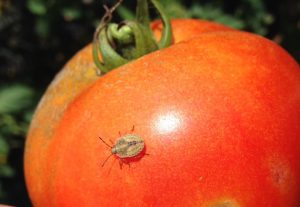
If stink bug fruit injury is increasing in harvests, or stinkbug adults, nymphs (see photo at right), or eggmasses are found in more than one of 10 samples in a field, consider treating for this pest to limit injury. See the 2016 Commercial Vegetable Recommendations Guide for insecticides effective against stinkbugs.
Many tomato plantings are now showing signs of foliar feeding. While this type of feeding (see photo at far left) can be caused by pests such as beet and yellow striped armyworms, the dominant insect in fields at this time is the cabbage looper. These caterpillars (see photo at near left) feed primarily on foliage, but will occasionally feed on green fruit, making small excavations on the sides. They do not bore into fruit as CEW or the armyworms do. We do not have an action threshold for this pest, but if injury to green fruit is increasing to unacceptable levels in the field, insecticides in the IRAC 28 class (Coragen, Exirel) or IRAC 5 (Entrust (OMRI approved), Radiant) are effective, and less likely to result in aphid rebounds than are broad spectrum insecticides.
Pepper weevil
No weevils were trapped in the past week. As far as known, there are no infested fields.
